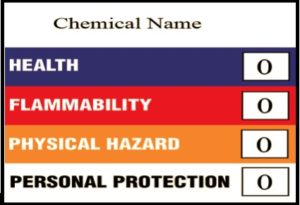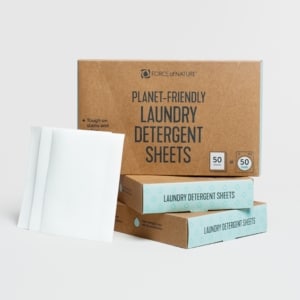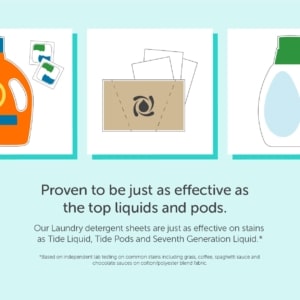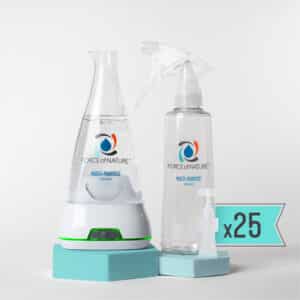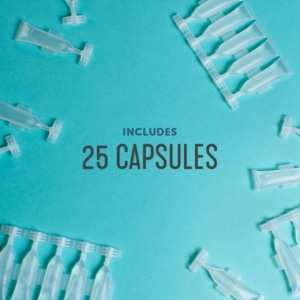SDS & TEST RESULTS:
Force of Nature Electrolyzed Water & Hypochlorous Acid Safety Data Sheet
PO Box 1145
Westford, Massachusetts 01886
Emergency Contact: 888-985-8099
1. Chemical Product and Company Identification
a. Common Name/Trade Name: Electrolyzed Water
b. Manufacturer/Supplier: Healthier Cleaning Innovations (See above)
c. Commercial Names: Hypochlorous Acid and Sodium Hydroxide mixture
d. Synonym: None
e. Chemical Name: Hypochlorous Acid, Sodium Hydroxide
f. Formula: H20; NaCl; HOCl; NaOH
g. Chemical Family: Inorganic salt solution in water – weak acid
h. CAS #: Mixture
i. RTECS: Not applicable
j. TSCA: Not applicable
k. CI#: Not applicable
2. Composition and Information on Ingredients
| Exposure Limits | |||||
| Name | CAS# | TWA (mg/m3) | STEL(mg/m3) | CEIL (mg/m3) | % by Weight |
| Water (H20) | >98% | ||||
| Sodium Chloride (NaCl) | 7647-14-5 | <0.5% | |||
| Hypochlorous Acid (HOCI) | 7790-92-3 | <0.05% | |||
| Sodium Hydroxide (NaOH) | 1310-73-2 | <0.00001% | |||
Toxicological Data on Ingredients: ORAL (LD50): >2000mg/kg
Note: Product Composition ranges shown are typical for health, safety, and environmental use and not intended as specifications.
3. Hazards Identification
Potential Acute Health Effects
a. Skin Contact: Those individually allergic to Chlorine should avoid direct contact as it may cause irritation with symptoms of redness, itching, and swelling.
b. Ingestion: Ingestion of large quantities (>greater than one liter or one quart) may produce gastric discomfort, nausea, vomiting, and diarrhea
c. Carcinogenicity: Active ingredients are not listed by OSHA, EPA, or any other authority as carcinogen or tumor promoter
Potential Chronic Health Effects:
a. Skin Effects: Negative
b. Eye Effects: Negative
c. Carcinogenic Effects: Negative
d. Mutagenic Effects: Negative
e. Teratogenic Effects: No known significant effects or critical hazards
f. Developmental Toxicity: No known significant effects or critical hazards
4. First Aid Measures
a. Inhalation: If dizziness occurs, immediately get into an open space – no other action is required.
b. Ingestion: Drink large quantities of water and consult with a physician.
5. Fire Fighting Measures
a. Flammability of Product: Non-flammable
b. Auto-ignition Temperature: Not applicable
c. Flash Point: Not applicable
d. Flammable Limits: Not applicable
e. Products of Combustion: Not applicable
f. Fire Hazards in Presence of Various Substances: None
g. Explosion Hazards in Presence of Various Substances: None
h. Fire Fighting Media and Instructions:
i. Choose extinguishing media suitable for surrounding materials, chemical type foam, sand, and water spray
ii. Respiratory and eye protection are required for fire fighting personnel. Full protective equipment (bunker gear) and self contained breathing apparatus (SCBA) should be used for all indoor fires and any significant outdoor fires. For small outdoor fires, which may be easily extinguished with a portable fire extinguisher, use of a SCBA may not be required. Do not allow chlorine gas to accumulate within a confined space. Insure proper ventilation to the outside.
i. Special Remarks on Fire Hazards: This product is a non-flammable substance
j. Special Remarks on Explosion Hazards: Not available
6. Accidental Release Measures
a. Small Spill: No special requirement. Wash to waste.
b. Large Spill: No special requirement. Wash to waste.
7. Handling and Storage
a. Precautions: No special handling required.
b. Storage: If containers are used, insure containers are located in a well-ventilated area.
8. Exposure Controls and Personal Protection
a. Respiratory Protection: Not necessary as long as there is adequate ventilation
b. Protective Clothing: Not required
c. Ventilation: Good room ventilation is normally adequate for a safe use of this product.
9. Physical and Chemical Properties
a. Physical State and Appearance: Liquid
b. Molecular Weight: Mixture
c. pH (1% soln/water): 5 to 7
d. Boiling Point: >100 degrees Celsius
e. Melting Point: <0 degrees Celsius
f. Critical Temperature: Not available
g. Specific Gravity: 1.0g/ml
h. Vapor Pressure: Not available
i. Vapor Density: Not available
j. Volatility: Not availability
k. Odor Threshold: Not available
l. Water/Oil Dist. Coeff.: Not available
m. Iconicity (in water); Not available
n. Dispersion Properties: See solubility of water
o. Solubility in Water: Easily soluble in cold water
p. Odor Characteristic: Slight chlorine-like, no added fragrance
q. Taste: Not available
r. Color: Colorless
10. Stability and Reactivity
a. Stability: The product is stable under normal conditions of temperature and pressure
b. Instability Temperature: Not available
c. Conditions of Instability: Not available
d. Incompatibilities: Ammonia, Acids
e. Corrosiveness: Oxidizer
f. Special remarks on corrosiveness: None
g. Hazardous Decomposition Products: Hypochlorous acid decomposes into chlorine
h. Polymerization: Will not occur
11. Toxicological Information
a. Routes of Entry: Absorbed through skin. Eye contact. Inhalation. Ingestion.
b. Toxicity to Animals: None
c. Chronic Effects on Humans: None
i. Carcinogenic Effects: Negative
ii. Mutagenic Effects: Negative
d. Other Toxic Effects on Humans: Negative
e. Special remarks on Toxicity to Animals: None
12. Ecological Information
a. Exotoxicity: Not available
b. BOD5 and COD: Not available
c. Products of Biodegrading: Negative
d. Toxicity of the Products of Biodegrading: The products itself and its products of degradation are not toxic
e. Special Remarks on the Products of Biodegrading: Not available
13. Disposal Considerations
a. Waste Disposal: No special precautions are required for this product
14. Transport information
a. DOT Classification: No special precautions for this product
b. Identification: Not applicable
c. Special Provisions for Transport: Not applicable
d. DOT (Pictograms): Not applicable
15. Other Regulatory Information and Pictograms
a. Federal and State Regulations:
i. United States: Health and Safety Reporting List: None of the chemicals are on the Health and Safety Reporting List
ii. Section 12b: None of the chemicals are listed under TSCA Section 12b
iii. TSCA Significant New Use Rule: None of the chemicals in this material have an SNUR under TSCA
iv. Clean Air Act: This material does not contain any hazardous air pollutants
v. OSHA: None of the chemicals in this product are considered highly hazardous by OSHA
vi. Canada: This product does not contain any known ingredient(s) on the “Ingredient Disclosure List”
vii. European Community Regulatory: All intentional ingredients are listed on the European’s EINECS Inventory
viii. State Regulations: Not available
ix. Local Regulations: Not available
b. California Proposition 65 Warnings: This product does not contain any chemicals known to the state of California that cause cancer, birth defects, or any reproductive harm.
c. Other Regulations: OSHA – Hazardous by definition of Hazard Communication Standard (29 CFR 1910.1200). To the best of our knowledge, this Safety Data Sheet conforms to the requirements of US OSHA 29 CFR 1910.1200.91/155/EEC and Canadian Hazardous Products Act.
d. Other Classifications:
i. WHMIS (Canada) – Not available
ii. DSCL (EEC) – Not available
e. HMIS (U.S.A.) – Not available
f. WHMIS (Canada): This product does not contain any known ingredient(s) on the “Ingredient Disclosure List”.
g. DSCL (Europe) – Pictograms: Not available
h. TDG (Canada) – Pictograms: Not available
i. ADR (Europe) – Pictograms: Not available
j. Protective Equipment: None
16. Other Information
a. MSDS Code: Not available
b. References: Not available
c. Other special considerations: Not available
d. Preparation Date: 7-28-16
Disclaimer: All chemicals may pose unknown hazards and should be used with caution. This Safety Data Sheet (SDS) applies only to the material as packaged. If this product is combined with other materials, deteriorates, or becomes contaminated, it may pose hazards not mentioned in this SDS. It shall be the user’s responsibility to develop proper methods of handling and personal protection based on the actual conditions of use. While this SDS is based on technical data judged to reliable, HCI, LLC assumes no responsibility for the completeness or accuracy of the information contained herein.
